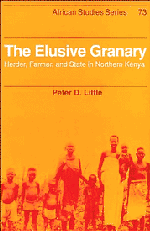Book contents
- Frontmatter
- Contents
- List of illustrations
- List of tables
- Preface
- 1 Introduction: the study of agrarian change among African herders
- 2 Society, ecology, and history
- 3 Markets and the state
- 4 Labor and agropastoral production
- 5 Income, wages, and investment
- 6 Expenditures, consumption, and the food crisis
- 7 Land conflicts and sustainability
- 8 In pursuit of the granary: development responses of community, donor, and state
- Notes
- References
- Index
- AFRICAN STUDIES SERIES
7 - Land conflicts and sustainability
Published online by Cambridge University Press: 04 August 2010
- Frontmatter
- Contents
- List of illustrations
- List of tables
- Preface
- 1 Introduction: the study of agrarian change among African herders
- 2 Society, ecology, and history
- 3 Markets and the state
- 4 Labor and agropastoral production
- 5 Income, wages, and investment
- 6 Expenditures, consumption, and the food crisis
- 7 Land conflicts and sustainability
- 8 In pursuit of the granary: development responses of community, donor, and state
- Notes
- References
- Index
- AFRICAN STUDIES SERIES
Summary
The food crisis, and more generally poverty, in Njemps directly affect the area's land use and ecology. Labor and capital constraints compel poor and very-poor homesteads to pursue a combination of dryland agriculture, small stock production with an emphasis on goat rearing, and wage employment. Rich and very-rich herders, on the other hand, focus predominantly on cattle and sheep production, irrigated agriculture, and nonfarm activities and investments that yield relatively high incomes. These different strategies create a plethora of land-use conflicts that at times require state intervention. Moreover, economic diversification strains the labor and capital resources of most herders, making it difficult for them to pursue any of these activities effectively, and generating unsustainable land-use patterns that damage the environment and complicate land rights in the area.
Land issues in Baringo are also complex because of (1) regional competition for land among ethnic groups, and (2) land-tenure policies. The threat of land appropriation by other groups is strong enough at times to mobilize the II Chamus community against “outsiders” in spite of internal differences. Many of these conflicts can be traced to the beginning of the century when the region's three main groups – Tugen, Pokot, and II Chamus – began periods of territorial expansion and migration. Many of the current disputes, therefore, are over land that none of the groups could actually claim as their “traditional” home areas until the last ninety years. As for land-tenure policies in the area, these are broadly defined by national institutions that regulate the use of local resources through the appointment of local chiefs who compete with indigenous authorities.
- Type
- Chapter
- Information
- The Elusive GranaryHerder, Farmer, and State in Northern Kenya, pp. 135 - 162Publisher: Cambridge University PressPrint publication year: 1992



